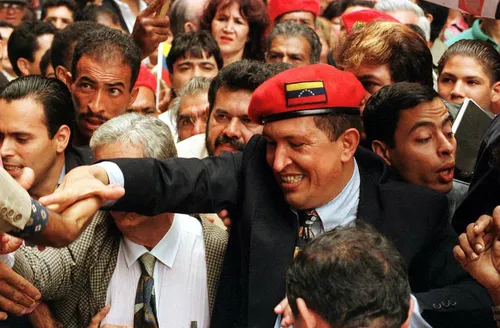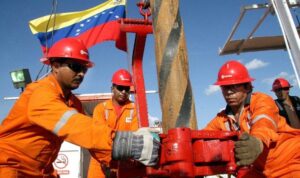
April 11, 2002, which turns 22 years old this Thursday (11), is marked in the history of Venezuela as the beginning of an attempted coup d’état that lasted three days and ended in failure. Former president Hugo Chávez emerged stronger from the episode, gained more support for his mandate and ended up raising the tone of his rhetoric, consolidating what became known as “Chavismo” as a socialist political-ideological movement.
According to historian Carlos Franco Gil, from the Central University of Venezuela, Chávez came to power in 1999 without a well-defined political-ideological line. The tension between government and opposition in the first years of his mandate was growing and culminated in the attempted coup against the government in 2002. From that moment on, the former president raised his tone against his opponents.
“There is a great radicalization of Chávez’s speech and the political tone surrounding the values that will underpin the Bolivarian project. When he comes to power, we don’t know what Chávez is, he is a confluence of several factors. With the 1999 Constitution, Chavismo began to define itself based on the elements that the traditional Latin American left has as its bases: nationalization, nationalization and income distribution. This is a period of tension, which ends up consolidating Chavismo. Chávez didn’t declare himself a socialist until 2006. In this first stage he raised his political tone, but I don’t remember him declaring himself a socialist at that moment,” said Gil.
April 11th was the high point of a crisis that had been going on since the beginning of the Chavista mandate in 1999. The opposition was gaining more and more echo in the Venezuelan middle classes and business sectors and, from November 2001, the protests began to have greater weight with strikes in the main sector of the Venezuelan economy: oil.
PDVSA was the public company that raised the most revenue and was strategic for any government in the country. Due to the size of Venezuela’s oil deposits, Chávez had in the state-owned company a source of financing for public projects and social programs that boosted his government. At the beginning of that April, company leaders were split with the government and began to promote strikes against Chávez.
The government’s response was harsh, and on the morning of Sunday, April 7, the former president used his television program Hello President to announce a series of layoffs in the company’s board of directors.
“Now, this PDVSA elite has crossed the line. They started to cross the line. So I announce the following. I announce the dismissal of the following people: Eddy Ramirez, managing director of Palmaven to this day, is out! We were given the responsibility of running a very important company like Palmaven, an oil branch. This Palmaven belongs to all Venezuelans, so Mr. Eddy Ramirez, thank you very much, you are fired, gentleman”, Chávez began announcing after blowing a whistle.
The message was harsh. Subsequently, different sectors took to the streets and protested until Chávez’s temporary departure from power.
According to historian Carlos Franco Gil, the participation of business sectors was fundamental in the coup attempt, which ended up using part of the population that didn’t even understand what was happening.
“There is an increasing pace of protests mobilized by the middle and upper classes of society. Progressively, they become more insurgent. Added to this are factors that are not active in contemporary politics, at least in an obvious way, as businesspeople were,” said the historian.
Television channels and newspapers began to put heavy pressure on the government. Until the day of the acts, channels with public concession Venevisón, Rádio Caracas, Globovisión e Televen they began to campaign against the government and Chávez’s measures which, according to Gil, “bombarded the population” with a “siege against the government”.
The day of the coup
The gathering of opponents began at 9 am on April 11, 2002, in front of the state-owned company’s headquarters in the Chuao neighborhood. Broadcast on television channels, the protesters went to the Miraflores Palace, headquarters of the Venezuelan government, led by Pedro Carmona Estanga, then president of the country’s largest business entity, Fedecámaras, and Carlos Ortega, president of the Venezuelan Workers Confederation.
Upon arriving at the Miraflores Palace, the protesters were repressed by national forces and the Caracas police – despite the latter being under the management of mayor Alfredo Peña, from the opposition. The pressure grows and Chávez is coerced by the Armed Forces to resign, under threat of bombings against the Government Palace. Refusing to leave office, the president ends up arrested and forcibly removed from Miraflores by the coup military.
“On that day, when the demonstrations broke out, internal conspiracies took place and the protesters, many of them unaware of what was happening, went to the Miraflores Palace with the promise that they were going to remove Chávez from power by force, based on the insurrection. Nothing in the democratic way, in the Constitution, but in a violent way. These mobilizations will lead to a series of regrettable events”, says Carlos Franco Gil.
From there, what historians call a “coup within a coup” begins. Pedro Carmona Estanga goes on television and states that he was assuming a transitional government. He announces the dissolution of the National Assembly, the suspension of the work of the Supreme Court of Justice and overturns all of Chávez’s measures.
With that, the game changed. Chavistas take to the streets in an expressive manner and demand the return of the elected president. The Caracas military arrests Carmona and ends the coup. According to Carlos Franco Gil, from that moment on, Hugo Chávez went through a turning point in his speech and raised the tone for the Bolivarian project until finding, in 2006, the profile of his government as socialist.
Route adjustment
According to historian Jesus Peña, one of the turning points in Chávez’s politics was his participation in the media. Newspapers became actively involved in politics during that period and the former president’s relationship with the media became more incisive.
“One of the main changes is the presence of Chávez in private media and the presence of state media. He starts to participate more in programs and has more frequent appearances in vehicles”, said Peña. According to him, Chávez used popular discontent with television channels to reformulate his participation in the media.
“People stopped believing in the media because they sold a bad image of the president that, in the end, had no results,” said Peña.
According to historians, Chávez also began to look suspiciously at some wings of militarism and had to reform the Armed Forces to ensure that other coup attempts would not at least involve the participation of the Army, Navy or Air Force.
The former president gained strength and popular support. Chávez used this to hold consultations such as the 2004 referendum, which discussed his stay in power. He receives 69.92% support and managed, little by little, to define his ideological base until he won the presidency in 2006 and presented his government as a socialist project.
“It comes from a heterogeneity of the different sectors that support it. It has support from people who are not left-wing. There are nationalists, workers, middle class citizens who support the Bolivarian movement. In other words, Chávez raises the political tone because he is moving towards a popular mandate that began with the approval of the constitution and continued with a series of organic laws, referenda and elections”, concludes Carlos Franco Gil.
Editing: Rodrigo Durão Coelho

Source: www.brasildefato.com.br

